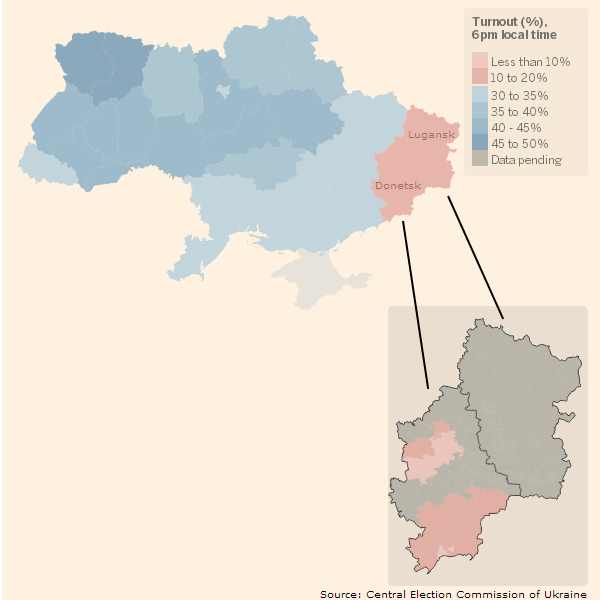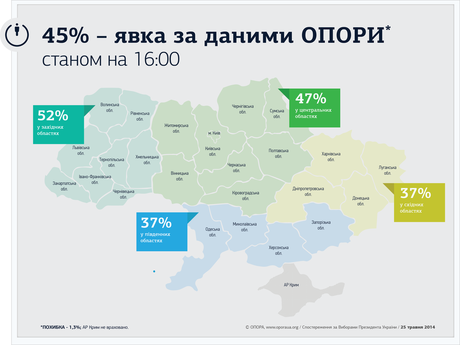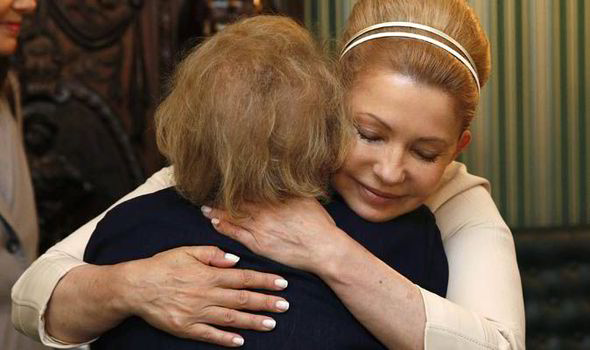According to exit polls, Pyotr Poroshenko is in the lead with more than 55 percent, with Fatherland Party rival Yulia Tymoshenko gathering approximately 12 percent of the vote.
According to the Central Election Commission, the overall turnout [6pm local time] was exceedingly low. Officially the number of polling stations is 32,244. Even in areas controlled by the Kiev regime, the voter turn-out was low.
According to official Ukraine governmental sources, there are 33.594 million registered votes on “mainland Ukraine” (i.e. excluding Crimea which is now under the jurisdiction of The Russian Federation). According to official sources, 474,000 Ukrainians living overseas can cast their vote at 114 polling stations in 75 countries.
While turnout in the two federalist oblasts of Eastern Ukraine (Donesk and Luhansk) was less than 10 percent, in most of the other regions, it did not exceed 45 percent of registered voters [6pm local time], with only one oblast in Western Ukraine in excess of 45%. (See Graph below, Financial Times based on official CEC data).
At 8pm local time the CEC announced, according to the Kiev Post, an overall turnout of 55.33 percent. This figure, however is misleading because it is based on an incomplete number of electoral precincts and it also excludes the Eastern Ukraine oblasts.
While the data –which is subject to political manipulation– is preliminary, the overall turnout is less than 50 percent. We will update as information become available.
The unofficial election watchdog OPORA quoted by the Kiev Post published the following figures:
International Observers
High quality global journalism requires investment. Please share this article with others using the link below, do not cut & paste the article. See ourTs&CsandCopyright Policyfor more detail. Emailftsales.support@ft.comto buy additional rights.http://www.ft.com/cms/s/0/681cc326-e3f5-11e3-a73a-00144feabdc0.html#ixzz32kkQAVdKAsked while voting if his first trip as president would be to the EU or Russia, Mr Poroshenko responded “To Donbass”, the name given to Ukraine’s heavy industrial south-eastern region.

Vadim Karasiov, a political analyst, said: “The card played by Russia will be in pointing out that the presidential election did not, de facto, take place in Donbass, [so] the newly-elected president does not represent this region.”
High quality global journalism requires investment. Please share this article with others using the link below, do not cut & paste the article. See ourTs&CsandCopyright Policyfor more detail. Emailftsales.support@ft.comto buy additional rights.http://www.ft.com/cms/s/0/681cc326-e3f5-11e3-a73a-00144feabdc0.html#ixzz32kkQAVdKAsked while voting if his first trip as president would be to the EU or Russia, Mr Poroshenko responded “To Donbass”, the name given to Ukraine’s heavy industrial south-eastern region.

Vadim Karasiov, a political analyst, said: “The card played by Russia will be in pointing out that the presidential election did not, de facto, take place in Donbass, [so] the newly-elected president does not represent this region.”
According to official sources, there were 3600 international observers.
Deutsche Welle placed the number of observers at 1200.
The US observer team is led by Madeleine Albright, who –in contradiction with her role as observer mission chief– openly expressed her preference for Tymoshenko.
(Tymoshenko hugs Madeleine Albright as they meet in Kyiv. picture right).
US senators Rob Portman (R-Ohio) and Benjamin Cardin (D-Maryland) were also part of the US observer mission.
According to reports no international observers were sent to East Ukraine.
It should be understood that the Right Sector which now controls the SUB (Ukraine’s Security Service) is exerting pressure on the offices of the Central Election Commission (CEC). According to recent reports, the electronic files of the CEC were hacked by CyberBirkut three days before the elections, which suggests that a manual recount will be required.
Ukraine’s Security Service claims that it has removed a virus at the Central Election Commission’s server, designed to delete the results of the presidential vote. According to the interior minister the cyber-attack may force a ‘manual vote count.’ The virus has been eliminated, software is replaced. So, we now have the confidence that the Central Election Commission’s server is safe,” Valentin Nalivaychenko, SBU head, is cited by UNN news agency. He is cited as saying that the virus was meant to destroy the results of presidential election on May 25. However the CEC programmers may not be able to fix the system in time for the elections, coup-installed Interior Minister Arsen Avakov announced on his website. (RT, May 24, 2014, emphasis added)
It follows from the statement of the Minister of the Interior that the electronic data system required to implement an orderly and transparent national election system was dysfunctional. This issue was casually ignored, it was not considered news worthy by the Western media.
Legitimacy of Elections?
The legitimacy of the elections is in doubt.
East Ukraine is in a war zone, where civilians are being shot at by Ukraine’s National Guard and security forces. Right Sector Neo-Nazis are in control of the National Guard.
The governments of both Lugansk and Donesk have declared Martial law. “Ukrainian troops have committed an act of aggression against civilians, the illegitimate Kiev government is carrying out a punitive operation against Lugansk republic,” said Valery Bolotov, the head of the republic.
Exit Poll Determines Outcome of Election?
Ironically, Poroshenko has been declared the winner by the Western media prior to the actual vote count. Moreover, Obama has officially congratulated him prior to an official confirmation by the Ukraine CEC.
While Poroshenko has declared victory, based on exit polls, under prevailing conditions, there is a possibility that the official vote count could be rigged (e.g. in favor of Tymoshenko), with a view to ensuring a runoff.
If this were to occur, it could potentially contribute to exacerbating the Ukraine crisis. Tymoshenko is supported by the Fatherland Party and the two Neo-Nazi parties. Right Sector and Svoboda. While Tymoshenko has little chances of winning in a runoff, she is the preferred candidate of the US establishment including the Council on Foreign Relations (CFR).
While Poroshenko is broadly supportive of the “Washington Consensus” including the IMF sponsored neoliberal reforms, Washington is anxious to bring Tymoshenko back into playing a more central political role, particularly with regard to the issue of Ukraine membership in NATO.
Both candidates serve Washington’s interests. They have a longstanding record of graft and corruption. They enriched themselves through the privatization programs launched in the wake of the collapse of Soviet Union.



